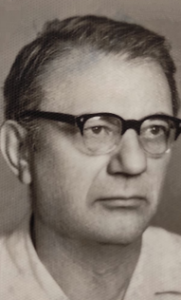Prof.Dr. Cahit Arf
Cahit Arf was born on October 11, 1910, in Thessaloniki. Due to the Balkan Wars that began in 1912, his family relocated to İstanbul. He began his education at the age of four at Beşiktaş Sultanisi. In 1915, following a major fire in Cihangir and Tophane, mostly wooden buildings, his family moved to Süleymaniye. Arf continued his education at İstanbul Sultanisi. In 1919, his family moved to Ankara, but after a brief period, they returned to İstanbul and later settled in İzmir.
Cahit Arf’s interest in mathematics was noticed by a teacher when he was a fifth-grade student in Izmir. This teacher encouraged him to solve Euclidean geometry problems and inspired him to pursue mathematics. In 1926, his family sent him to France to study at St. Louis Lycée in Paris. He managed to complete his three-year high school education in just two years and returned to Türkiye in 1928. At that time, Cahit Arf was selected among the candidates to be sent to Europe for higher education by the Turkish government. He completed his higher education at École Normale Supérieure in France in 1932. Upon his return to İstanbul, he worked as a mathematics teacher at Galatasaray Lycée for about a year and then started his academic career as an assistant professor at İstanbul University’s Faculty of Science.
In 1937, Cahit Arf obtained permission from İstanbul University and went to Göttingen University. He conducted his doctoral research under the guidance of Helmut Hasse and completed it in 1938. Among his other findings, he achieved a theorem that is now known as the “Hasse-Arf Theorem.” Cahit Arf faced the challenging period of World War II while studying in Göttingen, but upon Hasse’s recommendation, he stayed in Göttingen for an additional year. During this time, Arf developed the concept known today in the mathematical world as the “Arf invariant.”
In 1940, Arf returned to İstanbul University from Germany. He was promoted to a professorship in 1943 and to a full professorship in 1955. In 1949, he spent a year as a visiting professor at the University of Maryland, and in 1956, he was honored by being elected as a corresponding member of the Mainz Academy. He left İstanbul University in 1962 and in 1963, he worked as a teacher at Robert College in İstanbul. Subsequently, between 1964 and 1966, he worked at the Institute for Advanced Study in Princeton, USA. After spending an additional year in the United States, including a visit to the University of California, Berkeley, in 1967, he returned to Türkiye and joined the faculty of the Middle East Technical University in Ankara. Cahit Arf retired in 1980, and during his retirement, he continued his research at the Gebze Research Center, affiliated with TÜBİTAK.
Cahit Arf was one of the founding members of the Turkish Mathematical Society, established in 1948. He served as the president of the Turkish Mathematical Society from 1976 to 1982 and from 1986 to 1989. He played a significant role in the establishment and development of TÜBİTAK, which was founded in 1963, and for many years, he held the position of Chairman of the Scientific Board of this institution. Throughout his life, he continued to share his work with students and colleagues at Boğaziçi University.
Cahit Arf received several prestigious awards and honorary titles during his lifetime. In 1948, he was honored with the İnönü Award. In 1974, he received the TÜBİTAK Science Award. In 1979, he was granted an honorary doctorate from İstanbul Technical University, followed by honorary doctorates from Karadeniz Technical University in 1980 and Middle East Technical University in 1981. In December 1993, he was recognized with the title of Honorary Member of the Turkish Academy of Sciences, and on February 4, 1994, he was honored with the “Commandeur des Palmes Académiques” award from France.
Cahit Arf primarily conducted his most important work in the field of algebraic number theory. He invented Arf invariants, which have numerous applications in algebraic and differential topology. His early research was focused on quadratic forms over fields, particularly those with characteristic 2. Cahit Arf’s name is not only associated with Arf invariants in mathematical literature but also with the Hasse-Arf Theorem, which plays a crucial role in class field theory and Artin’s L-functions theory. Additionally, in mathematics, several concepts bear his name, such as Arf rings and Arf closures, highlighting his significant contributions and enduring influence on the field.
Cahit Arf, who passed away on December 26, 1997, as a result of a heart attack, was laid to rest at Zincirlikuyu Cemetery after a ceremony held at İstanbul University.
In 2001, the Turkish Mint, under the General Directorate of the Mint, released silver coins as part of the “Turks of a Thousand Years” Commemorative Coin Series. These coins featured Cahit Arf’s portrait on one side and a section of the formula known as the “Arf invariant” on the other side. Later, starting from January 1, 2009, the Central Bank of the Republic of Türkiye issued 10 Turkish Lira banknotes, which included a portrait of Cahit Arf and a section of the “Arf invariant” formula on the reverse side of the banknote. This recognition on currency serves as a tribute to his significant contributions to mathematics.
*This biography was compiled by our board member Özkan Değer for the booklet “TMD 75 Yılın Ardından,” prepared on the occasion of the 75th anniversary of the Turkish Mathematical Society.
